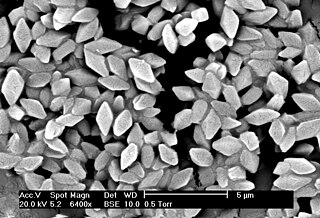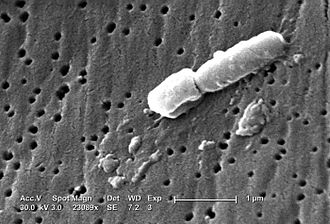
Bacillus thuringiensis is a Gram-positive, soil-dwelling bacterium, the most commonly used biological pesticide worldwide. B. thuringiensis also occurs naturally in the gut of caterpillars of various types of moths and butterflies, as well on leaf surfaces, aquatic environments, animal feces, insect-rich environments, and flour mills and grain-storage facilities. It has also been observed to parasitize other moths such as Cadra calidella—in laboratory experiments working with C. calidella, many of the moths were diseased due to this parasite.

Bacillus is a genus of Gram-positive, rod-shaped bacteria, a member of the phylum Bacillota, with 266 named species. The term is also used to describe the shape (rod) of certain bacteria; and the plural Bacilli is the name of the class of bacteria to which this genus belongs. Bacillus species can be either obligate aerobes: oxygen dependent; or facultative anaerobes: having the ability to continue living in the absence of oxygen. Cultured Bacillus species test positive for the enzyme catalase if oxygen has been used or is present.

Bacillus cereus is a Gram-positive, rod-shaped, facultatively anaerobic, motile, beta-hemolytic, spore-forming bacterium commonly found in soil, food and marine sponges. The specific name, cereus, meaning "waxy" in Latin, refers to the appearance of colonies grown on blood agar. Some strains are harmful to humans and cause foodborne illness, while other strains can be beneficial as probiotics for animals. The bacteria is classically contracted from fried rice dishes that have been sitting at room temperature for hours. B. cereus bacteria are facultative anaerobes, and like other members of the genus Bacillus, can produce protective endospores. Its virulence factors include phospholipase C, cereulide, sphingomyelinase, metalloproteases, and cytotoxin K.
Bacillus safensis is a Gram-positive, spore-forming, and rod bacterium, originally isolated from a spacecraft in Florida and California. B. safensis could have possibly been transported to the planet Mars on spacecraft Opportunity and Spirit in 2004. There are several known strains of this bacterium, all of which belong to the Firmicutes phylum of Bacteria. This bacterium also belongs to the large, pervasive genus Bacillus. B. safensis is an aerobic chemoheterotroph and is highly resistant to salt and UV radiation. B. safensis affects plant growth, since it is a powerful plant hormone producer, and it also acts as a plant growth-promoting rhizobacteria, enhancing plant growth after root colonization. Strain B. safensis JPL-MERTA-8-2 is the only bacterial strain shown to grow noticeably faster in micro-gravity environments than on the Earth surface.

Bacillus megaterium is a rod-like, Gram-positive, mainly aerobic spore forming bacterium found in widely diverse habitats. With a cell length of up to 4 µm and a diameter of 1.5 µm, B. megaterium is amongst the biggest known bacteria. The cells often occur in pairs and chains, where the cells are joined together by polysaccharides on the cell walls.
Waddlia is a genus of bacteria in its own family, Waddliaceae. Species in this genus have a Chlamydia-like cycle of replication and their ribosomal RNA genes are 80–90% identical to ribosomal genes in the Chlamydiaceae.
A Bacillus phage is a member of a group of bacteriophages known to have bacteria in the genus Bacillus as host species. These bacteriophages have been found to belong to the families Myoviridae, Siphoviridae, Podoviridae, or Tectiviridae. The genus Bacillus includes the model organism, B. subtilis, and two widely known human pathogens, B. anthracis and B. cereus. Other strains of Bacillus bacteria that phage are known to infect include B. megaterium, B. mycoides, B. pseudomycoides, B. thuringiensis, and B. weihenstephanensis. More than 1,455 bacillus phage have been discovered from many different environments and areas around the world. Only 164 of these phages have been completely sequenced as of December 16, 2021.

Stenotrophomonas is a genus of Gram-negative bacteria, comprising at least ten species. The main reservoirs of Stenotrophomonas are soil and plants. Stenotrophomonas species range from common soil organisms to opportunistic human pathogens, the molecular taxonomy of the genus is still somewhat unclear.

16S ribosomal RNA is the RNA component of the 30S subunit of a prokaryotic ribosome. It binds to the Shine-Dalgarno sequence and provides most of the SSU structure.
HutP is one of the anti-terminator proteins of Bacillus subtilis, which is responsible for regulating the expression of the hut structural genes of this organism in response to changes in the intracellular levels of L-histidine and divalent metal ions. In the hut operon, HutP is located just downstream from the promoter, while the five other subsequent structural genes, hutH, hutU, hutI, hutG and hutM, are positioned far downstream from the promoter. In the presence of L-histidine and divalent metal ions, HutP binds to the nascent hut mRNA leader transcript. This allows the anti-terminator to form, thereby preventing the formation of the terminator and permitting transcriptional read-through into the hut structural genes. In the absence of L-histidine and divalent metal ions or both, HutP does not bind to the hut mRNA, thus allowing the formation of a stem loop terminator structure within the nucleotide sequence located between the hutP and structural genes.
Zwittermicin A is an antibiotic that has been identified from the bacterium Bacillus cereus UW85. It is a molecule of interest to agricultural industry because it has the potential to suppress plant disease due to its broad spectrum activity against certain gram positive and gram negative prokaryotic micro-organisms. The molecule is also of interest from a metabolic perspective because it represents a new structural class of antibiotic and suggests a crossover between polyketide and non-ribosomal peptide biosynthetic pathways. Zwittermicin A is linear aminopolyol.

Bacillus anthracis is a Gram-positive and rod-shaped bacterium that causes anthrax, a deadly disease to livestock and, occasionally, to humans. It is the only permanent (obligate) pathogen within the genus Bacillus. Its infection is a type of zoonosis, as it is transmitted from animals to humans. It was discovered by a German physician Robert Koch in 1876, and became the first bacterium to be experimentally shown as a pathogen. The discovery was also the first scientific evidence for the germ theory of diseases.
In bacteriology, a taxon in disguise is a species, genus or higher unit of biological classification whose evolutionary history reveals has evolved from another unit of a similar or lower rank, making the parent unit paraphyletic. That happens when rapid evolution makes a new species appear so radically different from the ancestral group that it is not (initially) recognised as belonging to the parent phylogenetic group, which is left as an evolutionary grade.

Prosopis africana is a flowering plant species in the genus Fabaceae. It is found in Africa. Its common names include African mesquite, iron tree, gele (Malinke) or somb tree.
Bacillolysin is an enzyme. This enzyme catalyses the following chemical reaction
Burkholderia singaporensis is a bacterium from the genus Burkholderia and the family Burkholderiaceae.
Bryocella elongata is a bacterium, a type species of genus Bryocella. Cells are Gram-negative, non-motile pink-pigmented rods that multiply by normal cell division and form rosettes. The type strain is SN10(T). B. elongata was first isolated in 2011 from a methanotropic enrichment culture.

Brevinema andersonii, named for John F. Anderson, who first described the organism. This organism is a Gram-negative, microaerophilic, helical shaped, chemoorganotrophic organism from the genus Brevinema. Brevinema andersonii is host associated, strains have been isolated from blood and other tissues of short-tailed shrews and white-footed mice and are infectious for laboratory mice and Syrian hamsters.B. andersonii is readily identified by restriction enzyme analysis, and SDS-PAGE, or fatty acid composition data. Another identifier for B. andersonii is the sheathed periplasmic flagella in the 1-2-1 configuration. While cells are visible by dark-field or phase-contrast microscopy, they cannot be seen when bright-field microscopy is used.
Neobacillus is a genus of rod-shaped bacteria that show Gram-positive or Gram-variable staining. This genus belongs under the family Bacillaceae within the order Bacillales. The type species of Neobacillus is Neobacillus niacini.
Priestia is a genus of mostly Gram-Positive rod-shaped bacteria in the family Bacillaceae from the order Bacillales. The type species of this genus is Priestia megaterium.
















